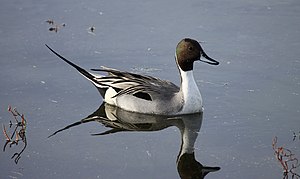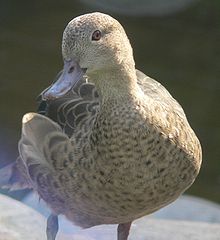Actual ducks
| Actual ducks | ||||||||||||
|---|---|---|---|---|---|---|---|---|---|---|---|---|

Pintail ♂ ( Anas acuta ) |
||||||||||||
| Systematics | ||||||||||||
|
||||||||||||
| Scientific name | ||||||||||||
| Anas | ||||||||||||
| Linnaeus , 1758 |
The actual ducks ( Anas ) are a genus from the subfamily of the ducks (Anatinae). The mallard is one of the best-known representatives of this genus in Central Europe . The only in the western part of Madagascar occurring Bernie pension that Campbell duck that on only 23 hectares Dent Iceland survived and only on the 370-hectare Laysaninsel living Laysan Duck also belong to this genus and are among the rarest water birds in the world.
features
In most species of this genus, especially if they are widespread in the temperate north, the drakes are significantly different from autumn to spring and have extremely splendid plumage. In the females, on the other hand, the plumage is not that different. Experience from keeping species of the real swimming ducks shows that many species are able to reproduce with one another. However, the progeny are generally sterile.
In contrast to the diving ducks of the genera Netta , Aythya and Bucephala , swimming ducks lie so high in the water that the rump stands out clearly. Swimming ducks only dive when there is danger or dig into the bottom of the water to search for food, which they can reach with their beak without completely detaching from the surface. When flying up, they stand up steeply from the surface of the water with their wings flapping without preparation.
Courtship
Many species show a very conspicuous courtship in the winter months . This begins at a time when the animals are not yet able to reproduce. The courtship regularly lasts until the spring months and includes postures, gestures and movements that are species-specific in their order. The long-term courtship serves to find partners of the same kind.
species



- Pintail ( anas acuta )
- Andaman white-throated duck ( Anas albogularis )
- Auckland Duck ( Anas aucklandica )
- Bahamian Duck ( Anas bahamensis )
- Amber duck ( Anas bernieri )
- Cape duck ( Anas capensis )
- Chestnut Duck ( Anas castanea )
- New Zealand Duck ( Anas chlorotis )
- Common teal ( anas crecca )
- Mexican duck ( Anas diazi )
- Eatonente ( Anas eatoni )
- Red-billed duck ( Anas erythrorhyncha )
- South American teal ( Anas flavirostris )
- Florida duck ( Anas fulvigula )
- Black-tailed Duck ( Anas georgica )
- Indonesian white-throated duck ( Anas gibberifrons )
- Australian white-throated duck ( Anas gracilis )
- Laysan Duck ( Anas laysanensis )
- Philippine Duck ( Anas luzonica )
- Madagascar duck ( Anas melleri )
- Campbell Duck ( Anas nesiotis )
- Mallard Duck ( Anas platyrhynchos )
- Spot-billed duck ( Anas poecilorhyncha )
- Dark Duck ( Anas rubripes )
- Black Duck ( Anas sparsa )
- Crested Duck ( Anas specularioides )
- Eyebrow Duck ( Anas superciliosa )
- Mauritius duck ( Anas theodori ), extinct
- Yellow-billed duck ( Anas undulata )
- Hawaiian duck ( Anas wyvilliana )
- Carolina teal ( Anas carolinensis )
Numerous duck species originally placed in the genus Anas were assigned to other genera in 2009, as it turned out that Anas in the old composition was not monophyletic . These are:
- Genus Mareca
- North American wigeon ( Mareca americana )
- Sickle duck ( Mareca falcata )
- Amsterdam ( Mareca marecula ), extinct
- Pfeifente ( Mareca Penelope )
- Chiloé Wigeon ( Mareca sibilatrix )
- Schnatterente ( Mareca strepera )
- Genus Sibirionetta
- Baikalente ( Sibirionetta formosa )
- Genus shoveler ( spatula )
- Cinnamon ( Spatula cyanoptera )
- Shoveler ( Spatula clypeata )
- Blue-winged duck ( Spatula discors )
- Hottentot Duck ( Spatula hottentotta )
- Australian shoveler ( Spatula rhynchotis )
- Cape shoveler ( Spatula smithii )
- Fox Shoveler ( Spatula platalea )
- Puna duck ( Spatula puna )
- Teal duck ( spatula querquedula )
- Versicolorente ( Spatula versicolor )
In Germany, in addition to the Mallard as wintering and then second most common duck in Central Europe teal represented, which, like the Pintail and Wigeon breeds in Northern Europe, broods in the summer with us wintering in Africa teal . However, pulling - - all year that can Shoveler be observed. Known as migrant is the Gadwall .
Etymology and history of research
The first description of the genus Anas was in 1758 by Carl von Linné, who assigned 39 species to it. "Anas, anatis" is the Latin word for "duck".
literature
- James A. Jobling: Helm Dictionary of Scientific Bird Names . Christopher Helm, London 2010, ISBN 978-1-4081-2501-4 .
- Hartmut Kolbe: Die Entenvögel der Welt , Ulmer Verlag 1999, ISBN 3-8001-7442-1
- Carl von Linné: Systema Naturae per Regna Tria Naturae, Secundum Classes, Ordines, Genera, Species, Cum Characteribus, Differentiis, Synonymis, Locis . 10th edition. tape 1 . Imprensis Direct Laurentii Salvii, Stockholm 1758 ( biodiversitylibrary.org ).
- Heinz-Sigurd Raethel : water and water ornamental poultry. Oertel and Spörer-Verlags GmbH + Co, Reutlingen 2003, ISBN 3-88627-513-2 .
- Erich Rutschke: The wild ducks of Europe . Deutscher Landwirtschaftsverlag 1989 Berlin (East). ISBN 3-331-00320-4
Web links
Individual evidence
- ↑ Gonzalez, J .; Düttmann, H .; Wink, M. (2009). Phylogenetic relationships based on two mitochondrial genes and hybridization patterns in Anatidae. Journal of Zoology. 279: 310-318. doi: 10.1111 / j.1469-7998.2009.00622.x
- ^ Proposal (787) to South American Classification Committee: Revise the generic classification and linear sequence of Anas
- ^ Waterfowl in IOC World Bird List
- ↑ Carl von Linné, pp. 122–128.
- ↑ James A. Jobling, p. 46